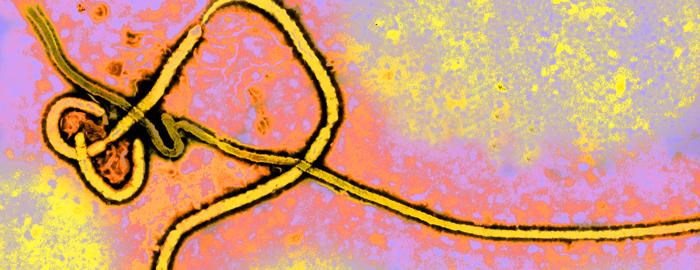New breakthrough paving the way for universal Ebola therapeutic

This is an Ebola photomicrograph. Credit: The University of Texas Medical Branch at Galveston
The Ebola virus causes a severe illness with high mortality rates in humans. Several strategies have been developed to treat Ebola infection, including ZMapp, which has been shown to be effective in non-human primates and has been used under compassionate-treatment protocols in humans.
“The trouble with ZMapp is that although it is effective against the Ebola species that was largely responsible for the last Ebola outbreak, it does not neutralize other Ebola species, including Ebola Bundibugyo, Reston or Sudan,” said virologist Alex Bukreyev, co-senior author and a University of Texas Medical Branch at Galveston professor in the department of pathology.
“We identified and studied three naturally-occurring antibodies from human survivors of Ebola Bundibugyo that neutralize and protect against infection with the several different Ebola virus species.”
The newly identified antibodies bond at a different site on the Ebola virus than other antibodies currently used to develop Ebola therapies.
Information on the Ebola virus:
According to the Centers for Disease Control, Ebola was first discovered in 1976 near the Ebola River in what is now the Democratic Republic of Congo. Since then, the virus has been infecting people from time to time, leading to outbreaks in several African countries.
Some of the different kinds of Ebola viruses are:
- Ebola virus (Zaire ebolavirus)
- Sudan virus (Sudan ebolavirus)
- Taï Forest virus (Taï Forest ebolavirus, formerly Côte d'Ivoire ebolavirus)
- Bundibugyo virus (Bundibugyo ebolavirus)
- Reston virus (Reston ebolavirus), known to cause disease in nonhuman primates and pigs, but not in people
Other authors include UTMB's Natalia Kuzmina, Philipp linykh, Xiaoli Shen, Kai Huang, Palaniappan Ramanathan, Thomas Ksiazek and Alexander Bukreyev; Andrew Flyak, Pavlo Gilchuk, Christopher Gulka, Rebecca Lampley, Nurgun Kose, Hannah King, Gopal Sapparapu, David Wright and James Crowe, Jr. from Vanderbilt University; Charles Murin, Hannah Turner, Marnie Fusco, Erica Ollmann Saphire and Andrew Ward from The Scripps Research Institute as well as Christopher Bryan, Edgar Davidson and Benjamin Doranz from Integral Molecular, Inc.
The study was supported by the Defense Threat Reduction Agency and the National Institutes of Health.
Media Contact
More Information:
https://www.utmb.edu/newsroom/article11767.aspxAll latest news from the category: Health and Medicine
This subject area encompasses research and studies in the field of human medicine.
Among the wide-ranging list of topics covered here are anesthesiology, anatomy, surgery, human genetics, hygiene and environmental medicine, internal medicine, neurology, pharmacology, physiology, urology and dental medicine.
Newest articles

Trotting robots reveal emergence of animal gait transitions
A four-legged robot trained with machine learning by EPFL researchers has learned to avoid falls by spontaneously switching between walking, trotting, and pronking – a milestone for roboticists as well…

Innovation promises to prevent power pole-top fires
Engineers in Australia have found a new way to make power-pole insulators resistant to fire and electrical sparking, promising to prevent dangerous pole-top fires and reduce blackouts. Pole-top fires pose…

Possible alternative to antibiotics produced by bacteria
Antibacterial substance from staphylococci discovered with new mechanism of action against natural competitors. Many bacteria produce substances to gain an advantage over competitors in their highly competitive natural environment. Researchers…





















